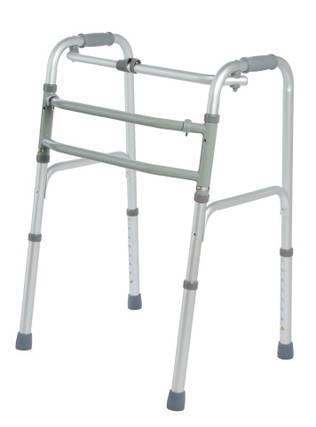WALKER FOR PAEDIATRIC PATIENTS
Description
Currently, technologies are being sought to facilitate movement and gait rehabilitation in child users. These technologies are focused on assisting the movement of the patient. This can be achieved by collecting information from sensors during use of the device, and transmitting said information to actuators that mobilize the structure or parts of it, such as exoskeleton-type joints. It is observed that the systems available on the market present a complex electromechanical interface, which translates into high-cost devices. The instrumentalized children's walker of the present invention allows the monitoring of pediatric patients with severe mobility difficulties that prevent their autonomous walking and solves existing problems thanks to its highly versatile structural configuration that allows it to be very easily adapted to different sizes of pediatric patients and to different walking assistance needs, depending on the pathology and its severity. The system incorporates a set of sensors for capturing kinematic and kinetic data, some housed in the structure of the walker itself and others that the therapist must place on the subject. The quantitative data acquired by the system during the development of specific assisted gait tests may be analyzed a posteriori by qualified health personnel to assess the severity of the gait impairment or monitor the evolution of the patient undergoing rehabilitation therapy.
Advantages
The advantages of the new walker are the following: • Quantitative gait monitoring system specific for paediatric patients with severe mobility pathologies that impede autonomous walking. • Versatile paediatric walker, configurable according to the size of the patient and their degree of mobility impairment. • Pediatric walker friendly for non-professional carers, as it is light, foldable, small, transportable and low cost. • Autonomous monitoring system, which can be used in clinical or non-clinical environments. • Device with the ability to communicate kinematic and kinetic gait data continuously to the specialist (rehabilitation doctor, physiotherapist...), even when the patient is outside a clinical environment. • The walker can be used independently by paediatric patients during their daily activities, with the help of their usual caretakers, who do not require specialised training. Although, the gathering and interpretation of the collected data should be performed by a specialist.
Uses and Applications
The application of the invention corresponds to the field of pediatric monitoring. • Clinics and professionals involved in the rehabilitation of mobility in paediatric patients, with neurological or motor impairments. • Motor pathology research centres. • Control of the patient's active recovery due to data acquisition. • Allows training, entertainment and rehabilitation of patients through a stable and safe system providing a safe use.
Keywords
Sectors
Areas
Patent Number
ES2974636A1 Expediente
Applicants
Universidad De Málaga
Inventors
José Juan Caballero Rodríguez, Oscar David De Cozar Macias, Maria Belen Estebanez Campos, Francisco Manuel Garcia Vacas, Maria Prado Novoa, Rita Pilar Romero Galisteo
Filing Date
14/11/2022
Protection Level: National (Spain)
Processing Status: Spanish protection application








